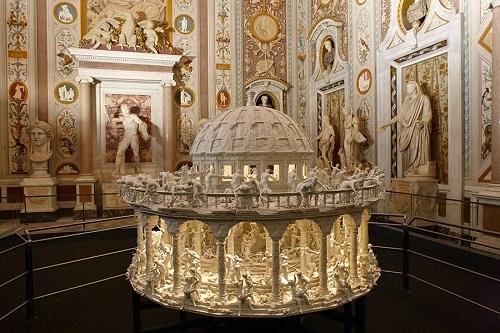Zoetrope, a vintage toy that was originally developed in the 1830s. And 3D printing brings a whole new level to the concept of the device.
The traditional zoetrope consists of a cylinder with cuts vertically on the sides, of which the inner surface is a band with images from a set of sequenced pictures. As the cylinder spins, the user looks through the cuts at the pictures across. The scanning of the slits keeps the pictures from simply blurring together, and the user sees a rapid succession of images, producing the illusion of motion.
All Things Fall By Mat Collishaw
This zoetrope is inspired by a painting by Ippolito Scarsella of The Massacre of Innocents. The work, named “All things Fall”, is made of steel, aluminum, plaster, resin, lit by LED lights and powered by an electric motor.


Collishaw says: “The Massacre of the Innocents painting functions in a very different way to the Caravaggio works I’ve selected. His paintings are solitary and melancholic, whereas the latter thrive on the repetition of characters spread across the canvas. They are designed to excite our emotions and to keep our eyes moving around the surface in an agitated manner without intimacy and with no focal point. The zoetrope capitalizes on this, literally repeating characters to create an overwhelming orgy of violence that is simultaneously appalling and compelling.”
Fibonacci Zoetrope by John Edmark
John Edmark created a series of 3D “Fibonacci zoetrope sculptures” that are designed to animate when spun under a strobe light. The placement of the appendages is determined by the same method nature uses in pinecones and sunflowers. The rotation speed is synchronized to the strobe so that one flash occurs every time the sculpture turns 137.5º — the golden angle.
“These are 3D printed sculptures designed to animate when spun under a strobe light. The placement of the appendages is determined by the same method nature uses in pinecones and sunflowers. The rotation speed is synchronized to the strobe so that one flash occurs every time the sculpture turns 137.5º—the golden angle. If you count the number of spirals on any of these sculptures you will find that they are always Fibonacci numbers.
For this video, rather than using a strobe, the camera was set to a very short shutter speed (1/4000 sec) in order to freeze the spinning sculpture.” says John about his creations.
How to make your own one?
You can find some nice STL files of DIY zoetropes from Thingiverse and other 3D model online platforms. Most of them do not require too much on your knowledge of the circuit.
For example, what you should prepare for this project littleBits is:
- a DC motor
- three bright LEDs controlled by a pulse
- a button in combination with a latch

